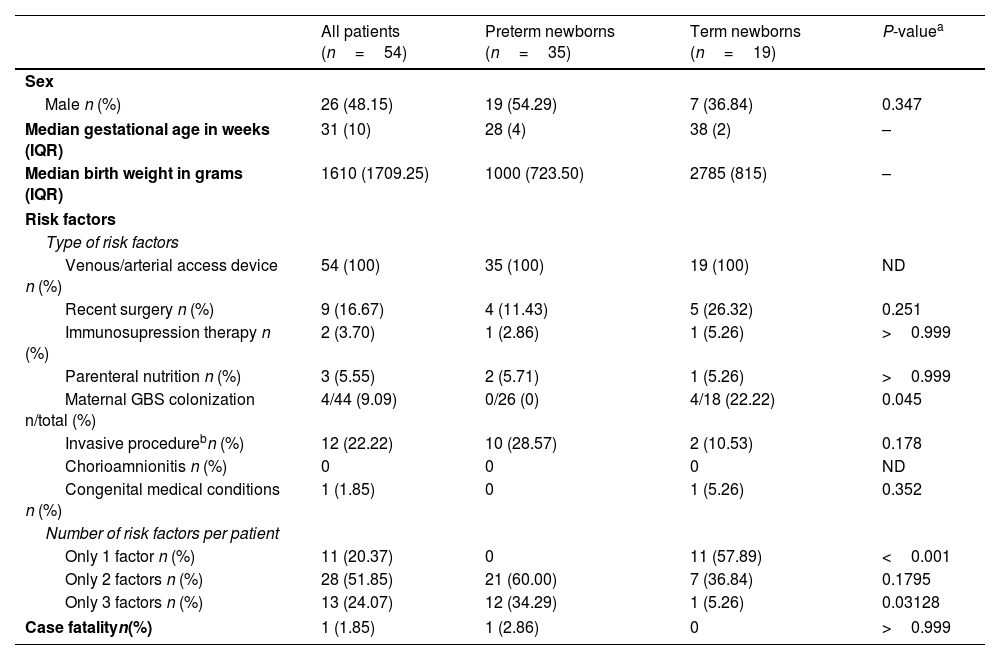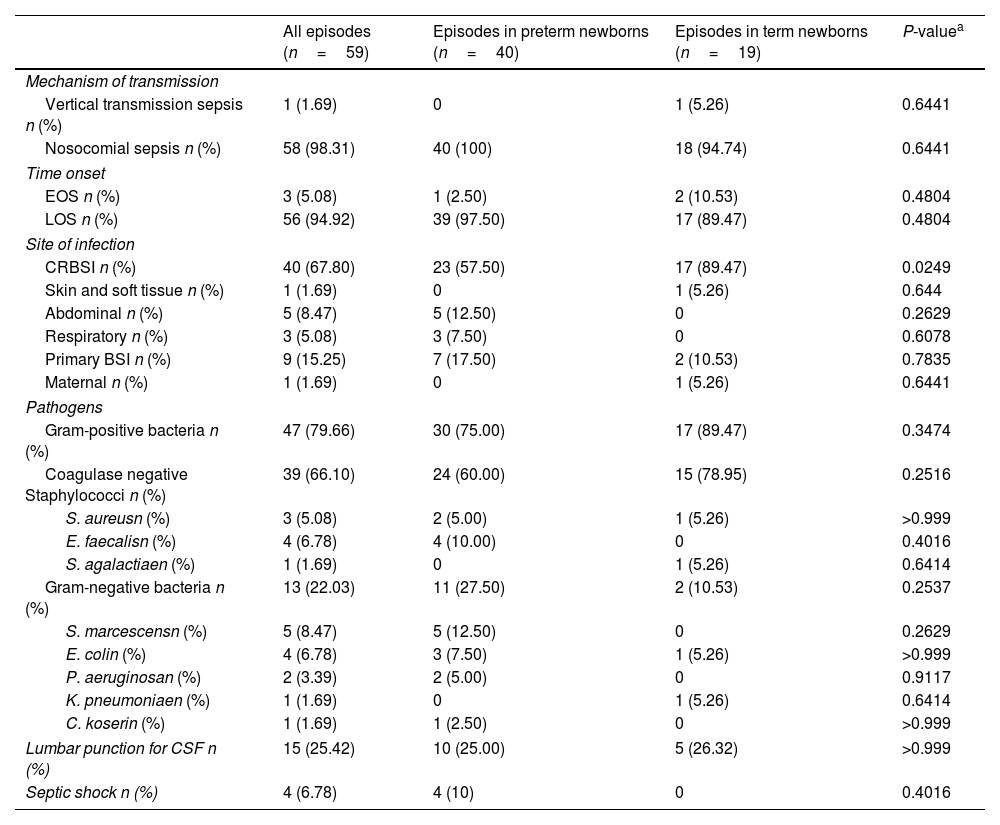Neonatal sepsis is a severe clinical syndrome that continues to be a common and significant health care burden. Knowledge of the local epidemiology allows for a better empirical treatment and improves morbidity and mortality. The aim of this study was to determine the prevalence, epidemiology, and etiology of blood culture-proven sepsis in neonates and to determine whether there are differences between preterm and term newborns.
MethodsA retrospective study was carried out in a tertiary hospital in Madrid, Spain, during 2021, including 1443 patients at risk of developing sepsis.
ResultsThe majority of sepsis episodes occurred in preterm newborns (64.81%) and most of them were very low birth weight infants (74.29%). Late-onset sepsis represented 94.92% of all the episodes reported with an incidence of 11.4 (95% CI 8.8–14.8) per 1000 live newborns. Early onset sepsis incidence was 0.6 (95% CI 0.2–1.8) per 1000 live newborns. Coagulase-negative staphylococci took the first place as causative agents of sepsis (66.10%), causing in all the episodes late onset catheter-related bloodstream infection. When the newborns who developed sepsis were compared with those who did not developed sepsis, the presence of venous/arterial access device was significantly associated with sepsis in both preterm (odds ratio (OR) 8.12, 95% CI 0.47–141.40) and term newborns (OR 16.58, 95% CI 1.00–275.20). Recent surgery was nevertheless the main risk factor in term newborns (OR 45.29, 95% CI 13.70–149.70). Among those patients who developed sepsis, no differences between preterm and term newborns were found regarding time onset, mechanism of transmission, etiological agents, and mortality. A 100% of the preterm and 42.11% of the term newborns presented two or more risk factors. The mortality rate observed here has been 1.85% (95% CI 0.33–9.77%).
ConclusionThe main risk factors for sepsis were venous/arterial access device (for both preterm and term newborns) and recent surgery (term newborns). Prematurity and being a catheter carrier were strongly associated with late-onset neonatal sepsis, mainly due to coagulase-negative staphylococci. The mortality rate was lower than that observed in other high-income countries.
La sepsis neonatal es un cuadro clínico grave y frecuente. El conocimiento de la epidemiología local permite un mejor tratamiento empírico y reducir la morbilidad y mortalidad. El objetivo de este estudio es determinar la prevalencia, la etiología y la epidemiología de la sepsis en los neonatos, y analizar si hay diferencias entre los recién nacidos prematuros y a término.
MétodosSe ha llevado a cabo un estudio retrospectivo en un hospital terciario de la Comunidad de Madrid, España, en el año 2021, incluyendo a 1.443 pacientes en riesgo de desarrollar sepsis.
ResultadosLa mayoría de los episodios de sepsis neonatal han ocurrido en recién nacidos prematuros (64,81%), y gran parte de ellos eran de muy bajo peso (74,29%). La sepsis de inicio tardío ha representado el 94,92% de todos los episodios, con una incidencia de 11,4 (IC 95%: 8,8-14,8) por cada 1.000 nacidos vivos. La incidencia de la sepsis de inicio precoz ha sido de 0,6 (IC 95%: 0,2-1,8) por cada 1.000 nacidos vivos. Los estafilococos coagulasa negativa han sido los principales agentes causales (66,10%) dando lugar todos ellos a sepsis de inicio tardío asociadas a catéter. Los resultados de este estudio sugieren que ser portador de catéter está asociado de forma significativa al desarrollo de sepsis, tanto en recién nacidos prematuros (odds ratio [OR]: 8,12; IC 95%: 0,47-141,40) como en los a término (OR: 16,58; IC 95%: 1,00-275,20). Además, en los pacientes que han desarrollado sepsis, no se han detectado diferencias estadísticamente significativas entre ambos grupos en cuanto al tiempo de inicio, el mecanismo de transmisión, la etiología y la mortalidad. El 100% de los prematuros y el 42,11% de los a término presentaron 2 o más factores de riesgo. La mortalidad observada en este estudio ha sido del 1,85% (IC 95%: 0,33-9,77%).
ConclusiónLos principales factores de riesgo para desarrollar sepsis han sido ser portador de catéter (prematuros y a término) y la cirugía reciente (a término). La prematuridad y el ser portador de catéter se han asociado fuertemente a sepsis neonatal de inicio tardío, principalmente por estafilococos coagulasa negativa. La mortalidad ha sido inferior a la observada en otros países de altos ingresos.
Article
Socio de la Sociedad Española de Enfermedades Infecciosas y Microbiología Clínica

Para acceder a la revista
Es necesario que lo haga desde la zona privada de la web de la SEIMC, clique aquí











